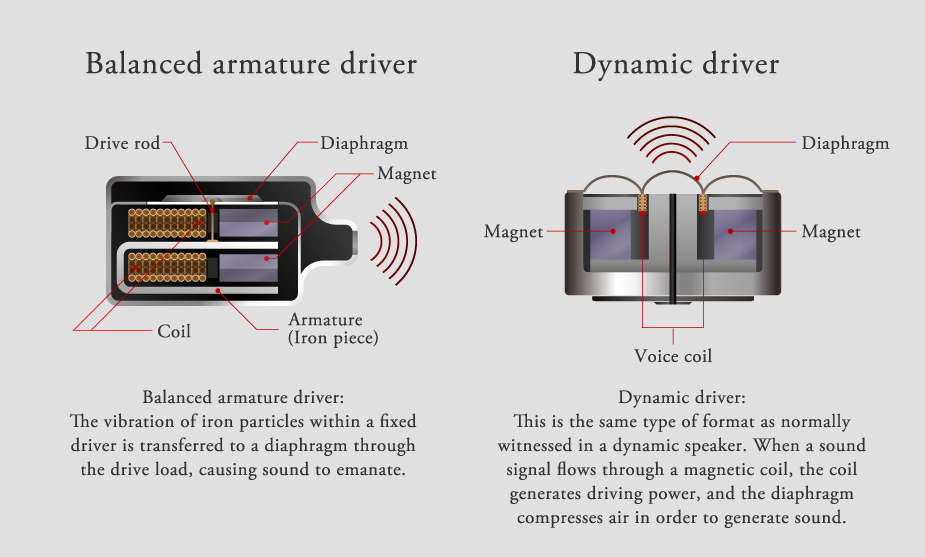About the Make Series
- Q1: Revenue targets for Makuake have been achieved, but are there product plans for the future?
- Q2: Please tell me about the earphones assembling workshop that led to the creation of these products.
- Q3: What is meant by good sound?
- Q4: What is meant by sound expansion? How about depth of sound?
- Q5: What is a balanced armature driver? What is a dynamic driver?
- Q6: What are the differences between Make1, Make2 and Make3?
- Q7: What are the differences between the sound of the Make1, Make2 and Make3 models? Which genres of music are recommended for which models?
Q1: Revenue targets for Makuake have been achieved, but are there product plans for the future?
A: Thank you for the kind support. We have product plans for MAKE1, MAKE2 and MAKE3 for the current year. Moreover, new products based on the MAKE Series are currently under development. When details have been finalized, we will communicate them over this site, or mail magazine and via SNS.
Q2: Please tell me about the earphones assembling workshop that led to the creation of these products.
A: For the earphones assembling workshop, we prepared special parts for these models and customers had the opportunity to learn about the earphone construction as they assembled earphones. The first such event held at the OTOTEN (AUDIO VISUAL FESTIVAL) held by the Japan Audio Society in 2011 received high appraisal, and 30 such events have been held over the past 7 years, including some held overseas, involving participation by more than 5000 active participants. Originally, earphone assembly was the main focus, but once we introduced parts such as filters and began to teach users about tuning, there was a really strong buzz about making one's own optimal sound and they evolved into tuning focused events.
Q3: What is meant by good sound?
A: At final, we believe that "good sound" has 2 meanings. The first is a scholarly definition of "precise sound". There is day-to-day scholarly research into how different types of sounds are perceived by the listener conducted in the fields of audio engineering and sound psychology, and we have compiled success from pilot programs involving products that leverage the latest research results. The second involves what an individual listener defines as "good sound". The important part here is what an individual listener feels, so by all means please search for your own optimal sound using the Make series.
Q4: What is meant by sound expansion? How about depth of sound?
A: Generally speaking, this refers to the sound field and playback in which there is good balance between the low range and high range sound in which an expansion of sound can be heard. Additionally, if the volume of low range sound is too high, it can mask other sound regions, making the sound field sound narrow.
Q5: What is a balanced armature driver? What is a dynamic driver?
A: Balanced armature driver: The vibration of iron particles within a fixed driver is transferred to a diaphragm through the drive load, causing sound to emanate.
Dynamic driver: This is the same type of format as normally witnessed in a dynamic speaker. When a sound signal flows through a magnetic coil, the coil generates driving power, and the diaphragm compresses air in order to generate sound.
Dynamic driver: This is the same type of format as normally witnessed in a dynamic speaker. When a sound signal flows through a magnetic coil, the coil generates driving power, and the diaphragm compresses air in order to generate sound.

Q6: What are the differences between Make1, Make2 and Make3?
A: Please refer to the comparison chart. The 3 models share a common form, but offer different driver configurations, surface finish of the chassis, cables and sound filter configurations.
Q7: What are the differences between the sound of the Make1, Make2 and Make3 models? Which genres of music are recommended for which models?
A: Make1 employs 3 Balanced Armature drivers, which are renowned for high resolution sound, and have been designed to generate natural overall sound in order to realize clear, expaning sound. This model is highly recommended for users with a strong penchant for sound quality.
Make2 employs a Balanced Armature driver for beautiful mid-range sound plus a dynamic driver for powerful bass to realize a lively fusion of sound achieved through final's proprietary tuning. This model is ideal tasting the heartwarming bass of rock music and electronic instruments.
Make3 emplys a single dynamic driver to cover the full range of sound in order to realize a natural sound expansion. This model thoroughly pursues a highbenchmark for basic sound.
Make2 employs a Balanced Armature driver for beautiful mid-range sound plus a dynamic driver for powerful bass to realize a lively fusion of sound achieved through final's proprietary tuning. This model is ideal tasting the heartwarming bass of rock music and electronic instruments.
Make3 emplys a single dynamic driver to cover the full range of sound in order to realize a natural sound expansion. This model thoroughly pursues a highbenchmark for basic sound.